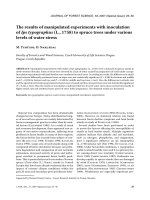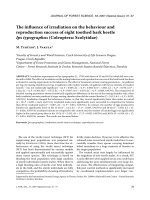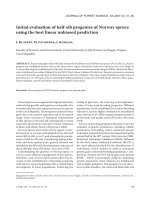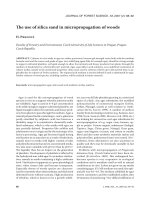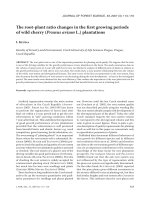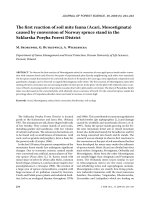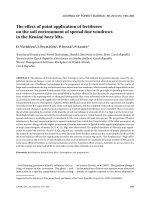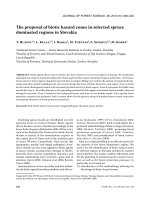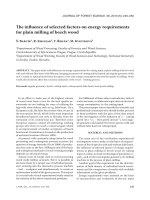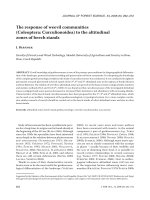Báo cáo lâm nghiệp: "The route of the pollen tube from stigma to ovule in Populus nigra : a new look" docx
Bạn đang xem bản rút gọn của tài liệu. Xem và tải ngay bản đầy đủ của tài liệu tại đây (968.91 KB, 6 trang )
The
route
of
the
pollen
tube
from
stigma
to
ovule
in
Populus
nigra :
a
new
look
M.
VILLAR,
INRA,
Station
M. GAGET
d’Amélioration
C. DUMAS
Arbres
forestiers
INRA,
Station
d’Amélioration
des
Arbres
forestiers
Ardon,
F
45160
Olivet
*
Université
Cl.
Bernard
Lvon
I,
RCAP,
UM
CNRS
3801124
F
69622
Villeurbantie
Cedex
Summary
The
complete
progress
of
the
Populus
nigru
pollen
tube
from
the
stigma
surface
to
the
ovule
micropyle
of
P.
nigru
has
been
examined
recently
by
the
classical
ABF
method
and
by
a
new
scanning
clectron
microscope
connected
to
a
cryogenic
preparation
system.
Key
word.s :
Po//<
’;!.
!7/!M,
ovule,
Populus.
1.
Introduction
Hybridization
programmes
in
Populus
are
limited
by
incompatibility
barriers
whose
cellular
sites
and
molecular
mechanisms
have
not
yet
been
defined.
In
spite
of
studies
dealing
with
incompatibility
in
Populus
in
the
last
decade
(WILLING
&
P
RYOR
,
1976 ;
S
TETTLER
&
A
GER
,
1984),
reproduction
events
especially
intra-pistillar
phenomena
have
not
been
clarified
yet.
During
an
investigation
of
these
events,
we
have
examined
the
pollination
pathway,
especially
the
behaviour
of
the
pollen
tube
from
the
stigma
surface
to
the ovule.
This
work
is
part
of
a
programme
on
interspecific
incompatibility
in
Populus,
involving
both
the
INRA
Station
d’Amélioration,
des
Arbres
forestiers
(Orleans,
France)
and
the
Université
de
Lyon,
Laboratoire
de
Reconnaissance
cellulaire
et
d’Amélioration
des
Plantes
(Villeurbanne,
France)
(G
AGET
et
al.,
1984
b).
2.
Materials
and
methods
Branches
of
Populus
nigra
bearing
flower
buds
were
forced
and
flowers
were
matured
in
growth
chambers
(at
the
Université
de
Lyon,
Villeurbanne,
France).
Before
pollination,
pollen
viability
was
checked
using
the
FCR
test
(Fluorochromatic
Reaction)
(HESLOP-HARRISON
&
HES
L
OP-HARRISON,
1970).
The
progress
of
the
pollen
tube
was
monitored
on
the
stigmatic
surface
and
in
the
ovary
cavity
by
scanning
electron
microscope
(SEM),
JEOL
35
CF
connected
to
an
EMSCOPE
SP
2000
cryogenic
system
(of
the
Centre de
Microscopie
Electronique
applique
à
la
Biologie
et
la
G6ologie,
Université
de
Lyon,
Villeurbanne,
France).
The
entire
flower
was
fixed
by
rapid
freezing,
fractured
and
gold
coated
at -
160 °C
before
observation.
Pollen
tubes
were
observed
in
the
stylar
tissue
by
the
decolorized
aniline
blue
fluorescence
method
(ABF)
in
cleared
whole
mounts
of
pistil
(D
UMAS
&
K
NOX
,
1983).
3. Results
A
Populu.s
nigra
catkin
is
composed
of
30
to
40
flowers
(fig.
2).
A
Populus
nigra
flower
is
represented
in
figure
1
and
3 :
the
bulbous
ovary
contains
many
ovules
and
is
surmounted
by
four
stigmatic
lobes.
Pollen
grain
adhesion,
hydration
and
germination
on
a
P.
nigra
stigmatic
surface
is
observed
in
figure
4.
Pollen
tubes
penetrate
the
stigma,
grow
through
the
stigmatic
lobes
and
join
together
within
the
funnel-shaped
stylar
neck
(stylodium,
fig.
5).
Somes
tubes
enter
the
ovary
cavity,
and
grow
on
the
inner
surface
(fig.
6).
They
reach
the
ovules
by
the
funiculus
(fig.
6),
or
directly
if
the
ovule
makes
contact
with
the
inner
ovary
wall.
After
25
hours
(20
&dquo;C)
the
pollen
tubes
pass
through
the
micropyle
of
the
ovules
(fig.
7).
4.
Discussion
Sexual
reproduction
in
Poplars
has
been
mainly
focused
on
the
observation
of
pollinated
stigma
surfaces
(H
AMILTON
,
1976,
S
TETTLER
et
al.,
1980).
The
behaviour
of
pollen
tubes
in
the
pistillar
tissue
has
rarely
been
described
(G
AGET
et
al,
1984
a).
In
this
paper
we
report
the
complete
progress
of
the
pollen
tube
from
the
stigma
surface
to
the
ovule
micropyle
for
the
first
time
for
the
genus
Populus.
The
route
of
the
pollen
tube
in
the
stigmatic
tissue
has
been
established
by
the
classical
ABF
method.
Complementary
and
original
observations
have
been
achieved
in
the
ovary
cavity
by
a
scanning
electron
microscope,
recently
connected
to
a
cryogenic
preparation
system.
After
rapid
freezing,
fresh
pistil
samples
are
fractured
at
low
temperature
before
observation.
The
visualization
of
the
pollen
tube
progress
in
this
cavity
has
raised
the
general
problem
of
the
guidance
of
the
pollen
tube
to
the
micropyle
of
the
ovule
(see
review
by
H
ESLOP
-H
ARRISON
&
H
ESLOP
-H
ARRISON
,
1985).
A
directional
change
in
the
pollen
tube
of
P.
nigra
at
the
base
of
the
funiculus
strongly
suggests
that
part
of
the
ovule
may
be
chemotropically
active
towards
the
pollen
tube.
Moreover,
these
two
physiological
methods
have enabled
us
to
establish
pollen
tube
growth
rate
in
P.
nigra
pistils
(V
ILLAR
et
al.,
1986),
and
to
reveal
the
sites
of
pollen
tube
arrest
in
an
incompatible
cross
(G
AGET
et
al.,
1984
a ;
V
ILLAR
,
1987).
These
modern
investigations
contribute
to
set
the
basic
features
of
reproduction,
and
of
male/
female
interactions
in
Populus.
Cheminement
du
tube
pollinique de
P.
nigra
du
stigmate
à
l’ovule
Nous
avons
examiné
les
principales
étapes
de
la
reproduction
sexuée
chez
le
Peuplier
noir
(Populus
nigra).
Cette
étude
présente
le
cheminement
du
tube
pollinique
de
P.
nigra
depuis
la
surface
stigmatique
jusqu’au
micropyle
ovulaire
(fig.
1
et
fig.
4
à
7).
Sa
progression
a
pu
être
observée
par
la
technique
classique
de
visualisation
des
tubes
polliniques
par
le
Bleu
d’Aniline
(méthode
ABF)
(fig.
5
et
7).
L’utilisation
du
microscope
électronique
à
balayage
couplé
à
un
système
cryogénique
EMSCOPE
SP
2000
a
permis
des
observations
complémentaires
originales
sur
le
devenir
du
tube
pollinique
après
pénétration
dans
lu
cavité
ovarienne
(fig.
6).
Mot.s
clés :
Pollen,
stigmate,
ovule,
Populus.
Références
D
UMAS
C.,
KN
ox
R.B.,
1983.
Callose
and
determination
of
pistil
viability
and
incompatibility.
Theor.
Appl.
Genet.,
67,
1-10.
G
AGET
M.,
S
AID
C.,
D
UMAS
C.,
K
NO
x
R.B.,
1984
a
Pollen-Pistil
interactions
in
interspecific
crosses
of
Populus
(Section
Aigeiros
&
Lf
tfff) :
pollen
adhesion,
hydratation
and
callose
responscs.
J.
Cell
Sci.,
72,
173-184.
G
AGET
M.,
V
ILLAR
M.,
D
UMAS
C.,
L
EMOINE
M
Ï
EHStËR
du
C
ROS
E.,
1984
b.
Poplar
improv-
ment :
new
stratégies
currently
in
progress
in
France.
Proc.
of
the
XVllth
Session
of
the
international
Poplar
commission,
Ottawa,
Canada,
25-30.
H
AM
mT
ON
D.,
1976.
Inter,!ectional
incompatibility
in
Populus.
PhD
thesis,
Australian
Nation3
1l
Univ.
Canberra,
Australia.
H
ESLOP
-H
ARR
tsoN
J.,
H
ESLOP
-H
ARRISON
Y.,
1970.
Evaluation
of
pollen
viability
by
enzymatically
induced
fluorescence,
intracellular
hydrolysis
of
fluorescein
diacetate.
Stain
Technol.,
45,
115-
120.
H
ESLOP
-H
ARRISON
J.,
H
ESLOP
-H
ARRISON
Y.,
1986.
Pollen-tube
chemotropism :
fact
or
delusion ?
In :
Biology
of
reproduction
and
cell
motility
in
plants
and
animal.
M.
Cresti
and
R.
Dallai
(Eds).
University
of
Siena,
Italia,
169-174.
S
TETT
LER
R.F.,
A
GER
A.A.,
1984.
Mentor
effect
in
pollen
interactions.
In :
Cellular
Interactions.
H.F.
Linskens
and
J.
Heslop-Harrison
(Eds).
Springer-Veriag
Berlin,
609-623.
S
TETT
LER
R.F.,
K
OSTER
R.,
S
TEENACKERS
V.,
1980.
Interspeeific
crossability
studies
in
Poplars.
Theor.
Appl.
Genet.,
58,
273-282.
V
ILLAR
M.,
1987.
Incompatibilité
interspécifique
chez
Populus :
approches
physiologique
et
biochi-
mique.
Diplôme
de
Doctorat,
Université
de
Lyon,
France.
V
ILLAR
M.,
G
AGET
M.,
D
UMAS
C.,
1986.
Sexual
reproduction
biology
in
Populus :
compatibility
and
incompatibility.
In :
Biotechnology
and
ecology
of pollen.
D.L.
Mulcahy,
G.B.
Mulcahy
and
E.
Ottaviano
(Eds).
Springer-Verlag,
NY,
514-517.
W
ILLING
R.R.,
P
RYOR
L.D.,
1976.
Interspecific
hybridization
in
Poplars.
Theor.
Appl.
Genet.,
47,
141-151.
